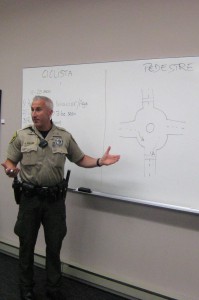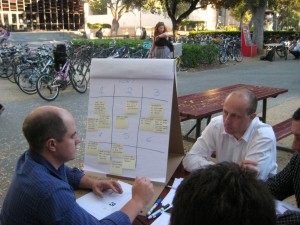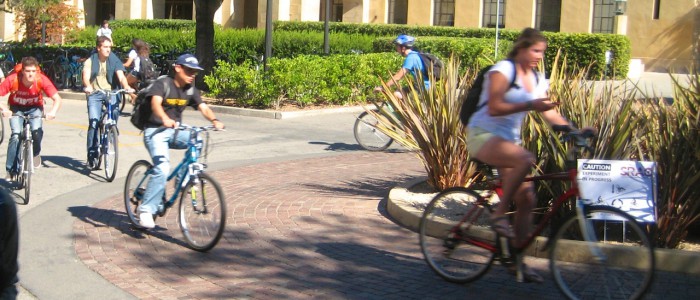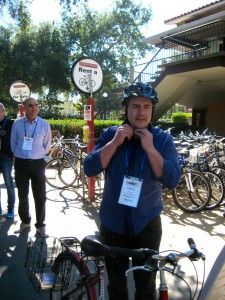SESI Santa Catarina collaborates with IntoActions to improve bike safety on the Stanford Campus
How do you introduce Human-Centered Design to participants in a 3-day Boot Camp on Design Thinking promoting bike safety on the Stanford campus? You put them on bikes, hand out helmets, give them some instructions and then send them off towards the ‘circle of death’ during rush hour.
Last week I worked with the MediaX Program at Stanford University to deliver a three-day design thinking bootcamp for one of their Affiliate Members from Brazil, SESI-SC.
MediaX is the industry affiliate program of the H-STAR Institute and helps its members to explore the use of technology to improve the human experience in a range of fields, from entertainment to learning to commerce. SESI-SC is the Serviço Social da Indústria, the Social Services Organization of the Brazilian Industry, and is based in the State of Santa Catarina in Southern Brazil. SESI-SC is particularly interested in technology to improve safer and healthier human behavior.
When we run our multi-day design thinking bootcamps at IntoActions, we always have a client that provides us with an authentic field challenge. We then use that challenge as a vehicle to introduce the design thinking process, key principles, tools and techniques which gives participants an opportunity to work in teams and learn by doing.
Improving bike safety on the Stanford campus was the ideal challenge to use for this boot camp, and our client was Stanford’s Department of Public Safety. Not only was bike safety closely connected to SESI’s interest in issues related to work safety and health, but it is also a major concern for the Department of Public Safety. There are close to 20,000 bikes on the Stanford campus, and the Department estimates that more than 300 cyclists are seriously injured while riding on campus each year.

Deputy Adam Cullen from Stanford’s Department of Public Safety presenting the challenge to the Brazilian delegation. (Photo © Reinhold Steinbeck)
Deputy Adam Cullen, who presented the challenge to the SESI-SC delegation at the beginning of the boot camp on behalf of the Department of Public Safety, mentioned that there are primarily three main issues related to bike safety: many students are not wearing bike helmets; a large number of bikes don’t have lights; and bikers don’t obey stop signs and other traffic rules.
During the second day of our boot camp participants applied various design thinking tools and techniques to better understand the problem space. They interviewed dozens of bicyclists, pedestrians and car owners, and used their mobile phones and cameras to capture bikers in action, especially around some of the hot spots on campus, such as the new roundabouts that students are referring to as the ‘circles of death’. Several teams recorded bike accidents during their field research.
To build empathy for the key stakeholders – in this case the bikers, the pedestrians and the car owners – it is not enough to speak with and observe them. We also asked the participants to immerse themselves to better understand the situation that the key stakeholders are in, and for which they were tasked to design a solution.
They had already been pedestrians on campus during the previous days, and they have experienced what it’s like to weave through thousands of bikes during the change of classes. On the second day, we rented bikes for all participants, gave them helmets and an introduction to campus and some of the key issues related to bike traffic and safety, and then sent them off for three hours to experience what it’s like to be a biker on campus. We refer to this approach of understanding the problem space as the ‘triangulation for empathy’: 1. What people say they are doing. 2. What people are doing? 3. What people are experiencing.

Participants working outside the Stanford bike shop to unpack the data they collected. (Photo © Reinhold Steinbeck)
After their ‘field immersion’ the teams stayed within the context and used various tools and techniques to ‘unpack’ and organize the information that they collected. One of the key takeaways from their field research was that designing a bike safety solution was much more than creating innovative helmets or lights.
At the end of the three-day boot camp the solutions created by the SESI-SC teams were presented to the Department of Public Safety. Rick Rondeau, a sergeant with the Department, was particularly impressed by a helmet that would fold like an umbrella. The insight that the team walked away with from their field research was that students don’t like to carry their bulky helmets with them to class. And when they attach them to their bikes, they might get stolen. The connection to using an umbrella was an excellent analogy, a powerful technique with design thinking for developing unique user insights.




